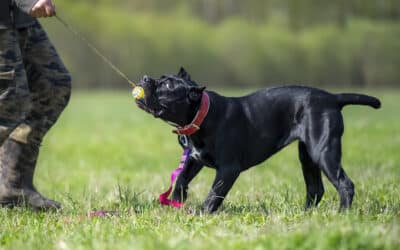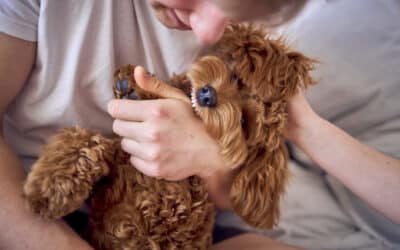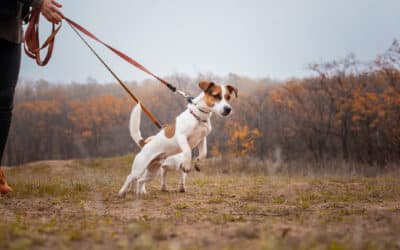Bringing a new puppy into your home is fun and exciting! Until they start chewing your things and biting your hands… ouch! That’s why we have made a free eBook: The ultimate guide to stopping puppy biting and chewing, which will help you understand puppy biting from your dog’s perspective and give you tips and strategies to help you prevent or stop biting and chewing in a positive and effective way.
Why do puppies bite and chew?
Before you can effectively stop your puppy from chewing and biting, it’s important to understand why puppies bite.
Puppies explore the world with their mouths and use their teeth during playtime with their siblings and parents.
Just like babies, puppies go through a teething phase which causes discomfort and leads to increased chewing and biting behavior.
Note: Puppies quickly learn that they can get people’s attention when they first bite them or other objects, so watch your reaction carefully! Your reaction can inadvertently reinforce the unwanted behavior, as they may see it as a way to get attention or playtime.
There are many ways to help your puppy understand appropriate vs. inappropriate biting and chewing. We will touch on some of the points below. However, please download our free puppy biting and chewing eBook for more detailed tips and strategies.
Using positive reinforcement to reward good behavior
Positive reinforcement is a powerful training tool for shaping your puppy’s behavior while building trust and a strong bond. By rewarding desirable behavior, such as playing with a toy, relaxing calmly or coming when called, you can encourage your puppy to repeat that behavior in the future. Being rewarded for good behavior will, in time, reduce “naughty” behaviors. Your dog will learn what they should do, instead of just being told what not to do all the time.
Timing and consistency are key when using positive reinforcement. Reward your puppy immediately during or after good behavior, and be consistent in your rewards. Puppies understand “you are good right now”, not “you were good a minute ago”.
Use treats, praise, and toys as rewards to keep your puppy engaged in the training process. The more you learn about what your puppy finds valuable and rewarding, the easier it will be to train them.
Read more about rewarding here >>
Avoid punishing your puppy as that can lead to fear and anxiety and a loss of trust in you. Instead, focus on reinforcing positive behavior and redirecting undesirable behavior.
With patience and consistency, positive reinforcement can help you and your puppy build a strong connection.
Providing safe and appropriate toys and chews
Puppies need to chew. To help prevent your puppy from chewing your things, it’s important to provide safe and appropriate alternatives for your puppy to chew on. Chew toys can help alleviate discomfort from teething and redirect your puppy’s attention.
Before you start a play session with your pup, make sure you have a toy handy and try to engage them with that before they go for your hands. When your puppy starts to bite, redirect their attention to an appropriate chew or toy. Praise them when they chew on the toy instead of inappropriate objects or body parts. This will help reinforce what is acceptable to bite and what is not.
Remember! Always supervise them when they are chewing to ensure their safety. If your puppy starts to destroy a toy, take it away and replace it with a new one to avoid any choking hazards.
Mental and physical stimulation
Providing your puppy with regular exercise and playtime is important for their physical and mental health. It’s not just about burning excess energy, appropriate play gives your puppy the mental stimulation they need to be calm and happy.
To provide appropriate outlets for your puppy’s energy, consider their age, breed and size. Keep sessions short and fun. It’s better to do two 10-minute sessions in the day than one 20-minute one!
During playtime, reward your puppy when they play nicely, come when called or follow commands / cues from you. This will help reinforce good behavior and make playtime a positive experience for both you and your puppy.
Mental stimulation can include puzzle toys, training sessions, and games. This will help prevent boredom and unwanted behavior, and also strengthen your bond with your puppy. It’s much better to do a 5-minute trick or agility foundation training session than 5-minutes of ball fetch. Your puppy will be calmer and more settled, rather than over-aroused and hyped-up.
Redirecting your puppy’s attention to prevent biting and chewing
Puppies are like children, they can easily become overstimulated and need to be redirected to more appropriate behavior.
If you notice your puppy is about to bite or chew you or your things, try redirecting their attention to something more appropriate for them to play with. This can also help reinforce what is acceptable to bite and what is not.
If your puppy is becoming irritable at the same time, it could be a sign that they are over-tired and it’s a good idea to give them a break in their puppy pen for a while, assuming they are already comfortable resting in it. The puppy pen or crate should never be used as a punishment tool.
Here are some tips for redirecting your puppy
- Have a variety of toys and chews available for your puppy to play with and encourage your puppy to interact with them by moving them around quickly on the ground.
- Use excited praise to encourage your puppy to play with appropriate toys.
- Be consistent in redirecting your puppy’s attention, and make sure everyone in the household is on the same page. Allowing your puppy to tug with socks or clothes will come back to bite you later on!
- Show your puppy how much fun it is to play with you using a toy. The more they value toys, the more likely they will choose those as their chew target – instead of your hand!
The importance of desensitization to prevent biting
Some puppies’ biting behavior presents itself as nipping things that move quickly (like children running). To prevent this from becoming a problem, it’s important to desensitize your puppy to moving things.
Desensitization involves gradually exposing your puppy to different moving objects from a distance, starting with slow and steady movements and gradually increasing the speed, intensity and proximity of the object. Reward and praise your puppy for good behavior. Don’t be afraid to take a few steps back if your puppy is at all uncomfortable. Slow and steady wins the race here!
Teaching patience and impulse control can also help your puppy stay calm around moving objects. For example, teaching the “leave it” command/cue to your puppy helps them learn to ignore or move away from something that may be dangerous or inappropriate. Here’s how to do it:
- Start with your puppy on the lead and say “leave it” as you reward the puppy immediately several times.
- Repeat this while a helper starts moving an object around near the puppy. As soon as the puppy shows interest in the object, repeat “leave it” and reward them.
- Continue this with different objects and in different environments until you can trust your puppy will respond even when off the lead.
- Consistent, positive reinforcement is the key to teaching this cue effectively.
Patience and consistency is the key to stopping puppy biting and chewing
The easiest way to prevent problems like biting before they become a big issue is by following a training plan created by professional dog trainers, such as the OneMind Dogs Puppy Training Program.
Get peace of mind knowing that you are covering all of the bases and setting yourself and your puppy up for success in the future.
Consistency and patience are key when it comes to training a puppy. It takes time and repetition for puppies to learn new behaviors and understand what is expected of them. Remember to be patient and not get frustrated with your puppy. Consistency in training and expectations will help your puppy learn faster and avoid confusion.
Get more detailed tips and strategies in our free ebook: The ultimate guide to stopping puppy biting and chewing 👇



